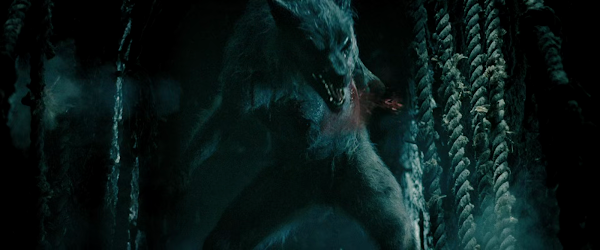To rectify this, the neck pieces were now made of a more spandex-like fabric material, allowing the performer inside to have more movement. More fur was added to the Lycan heads; partly to cover the softer fabric necks, but also to now give them a more 'wild' appearance. The leg extensions were also changed slightly to give them wider 'paw prints', allowing them to walk in them better. Just like the suits on the previous film, the performers had to be coated in KY jelly in order to slip in the tight suits easier.
When it came to William, the ancestor of the Lycans, Tatopoulos and Wiseman decided to go for a 'more traditional werewolf as you know them, with a wolf head', with Tatopoulos sketching the design. A preliminary maquette was sculpted to help visualize what Tatopoulos' William design would look like as a physical object.Wiseman was particularly focused on how the William werewolf's face should look, 'Patrick and I went through a lot of designs (...) drawing the jawline making it look (...) bulky, so it looked mean, and not this pointy Wile E Coyote look, and that's what happens quite a bit'. The William werewolf's animatronics built into the head needed three puppeteers to operate. A dummy head was created for the monster's demise.
Only one William suit was created, with its fur tailored on top of the undersculpture; hours were spent individually tying each hair in the suit. Guy Himber recounted, 'We feel bad whenever we cover (William) in blood (...) because they're really beautiful, but these things happen!'. Like the 'grunt' Lycan suits, the William suit had its neck moulded in spandex to allow the performer greater movement, with the neck fur concealing a hole that allowed the performer to breathe and see. Tatopoulos designed Marcus Corvinus, the ancestral vampire, as his idea of 'what a full-blown vampire creature looks like'. Still adhering to the focus on practical effects, Marcus would be realized via actor Tony Curran being coated in a full-body makeup. To visualize the makeup design, with a preliminary maquette was sculpted by Steve Wang. Two different facial makeups were sculpted for Tony Curran as Marcus, according to Guy Himber, 'We have one that we've affectionally called the 'battle face' which is a little more pronounced, a little more severe in the face. And then we have one that's kind of a dialogue face where we've taken some of these things back just to allow him to read more through the makeup. Several stages of makeup were constructed, with the first stage being a 'fresh out of his sarcophagus look' as Himber called it.It would take seven hours to apply all the makeup prosthetics on Curran, Also sculpted on the back were closed wings, as Wiseman did not want it to look like the wings came out of nowhere; the half-unfolded wings that he used as a weapon were practical extensions created by Tatopoulos' team. A similar makeup was applied to Curran's stunt double as well Adrian Hein.
Several facial prosthetics were also sculpted for the slowly transforming 'fresh' Lycans bitten by William. Face and chest prosthetics were also applied to Scott Speedman once more, this time to show him with a more wolf-like appearance in the face.























































































No comments:
Post a Comment